2018 Oregon ACP Resident Presentations

OHSU Internal Medicine Resident Clinical and Research Abstract Presentations
American College of Physicians Oregon Chapter Scientific Meeting
November 8, 2018 ~ Salem, Oregon
Winners:
Oral Vignettes:
First place--Dr. Joel Burnett, "An Unnerving Situation"
Third place--Dr. Logan Jones, "This Case is Nuts"
Clinical Vignettes:
Second place--Dr. Tyler Wells, "HIV: A Covert Risk Factor For Coronary Artery Disease"
Third place--Dr. Matt O'Donnell, "In The I-Odine Of The Thyroid Storm"
Clinical Research:
First place--Dr. Joaquin Chapa, "Interpreting The Effectiveness Of Cancer Screening From National Population Statistics: Is It Sound Practice?"
High Value Cost Conscious Care:
First place--Dr. Kaleb Keyserling, "Call Me Maybe? Improving Utilization Of Telemedicine In A VA Resident Clinic"
Oral Presentations

An Unnerving Situation - 1st Place
Joel Burnett, MD
Faculty Mentor: Christopher Terndrup, MD
Cauda equine syndrome (CES) is an important neurologic disorder characterized by lower back pain, perineal numbness, and sphincter dysfunction. Etiologies of CES include intervertebral disk herniation, chronic lumbosacral stenosis, trauma, tumors, and certain viral infections. In this case, a woman with chronic spinal stenosis developed subacute CES after acute HSV infection, underwent spinal imaging and surgical evaluation, was judged to have insufficient spinal stenosis to account for CES, and over time experienced spontaneous symptom improvement. This presentation is best explained by Elsberg syndrome, a manifestation of a primary infection or reactivation of HSV-2 consisting of acute/subacute sacral radiculitis. The syndrome presents with CES of acute/subacute onset and recent or coexisting HSV infection in the absence of alternative CES causes.
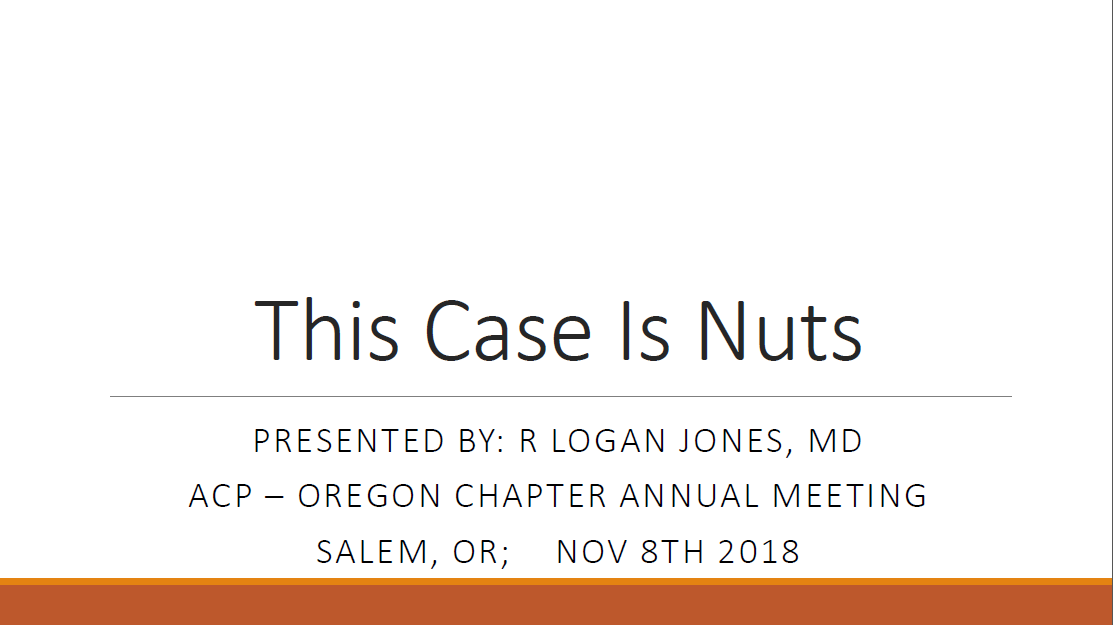
This Case Is Nuts - 3rd Place
R Logan Jones, MD
Faculty Mentors: Brian Ricci, MD; Pavan Chopra, MD
Hyperoxaluria is a condition characterized by increased urine oxalate content and are prone to recurrent nephrolithiasis. When encountered, secondary causes should be considered including dietary sources. This case illustrates the importance of performing recommended dietary history, stone analysis, and 24-hour urine collection on patients with recurrent nephrolithiasis. In patients with hyperoxaluria, dietary history and counseling should include avoidance of high oxalate containing foods such as leafy greens, chocolate, potatoes, and nuts.
Clinical Vignette Posters
Fever and Rash: the Perplexing Presentation of a Common Disease
Shahana Baig-Lewis, MD, MPH
Faculty Mentor: Targol Saedi, MD, FACP
Most people will be infected with Epstein-Barr virus during their lifetime and remain asymptomatic. Common associated signs/symptoms include fatigue, fever, sore throat, lymphadenopathy, hepatosplenomegaly, rash, neurologic disorders and hematologic disorders including cytopenias which can mimic other rheumatologic, malignant or viral diseases. Checking antibodies against EBV capsid antigen, which typically appear at the onset of acute infection and remain positive for life, EBV nuclear antigen-2 and EBV early Ag can be helpful in diagnosis.
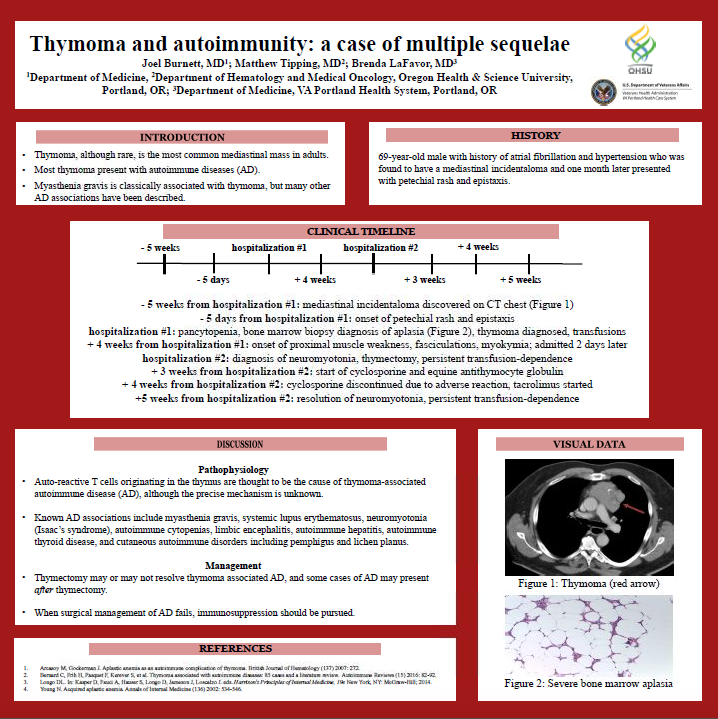
Thymoma and Autoimmunity: a Case of Multiple Sequelae
Joel Burnett, MD, Matthew Tipping, MD
Faculty Mentor: Brenda La Favor, MD
Thymoma, an uncommon neoplasm arising from the thymus, is classically associated with myasthenia gravis and pure red cell aplasia. However, the condition is also associated with numerous other paraneoplastic autoimmune diseases (AD), including thyroiditis, acquired neuromyotonia, oral lichen planus, aplastic anemia, and acquired hypogammaglobulinemia. This case highlights the strong association between thymoma and AD. A recent case series identified autoimmune disease in 55% of patients with thymoma; 7% of patients presented with multiple AD. As in this case, AD is often present at thymoma diagnosis (68%). Thymectomy often improves symptoms in paraneoplastic myasthenia gravis. However, the benefit of thymectomy is less clear with other AD as they may develop after thymectomy in some cases.
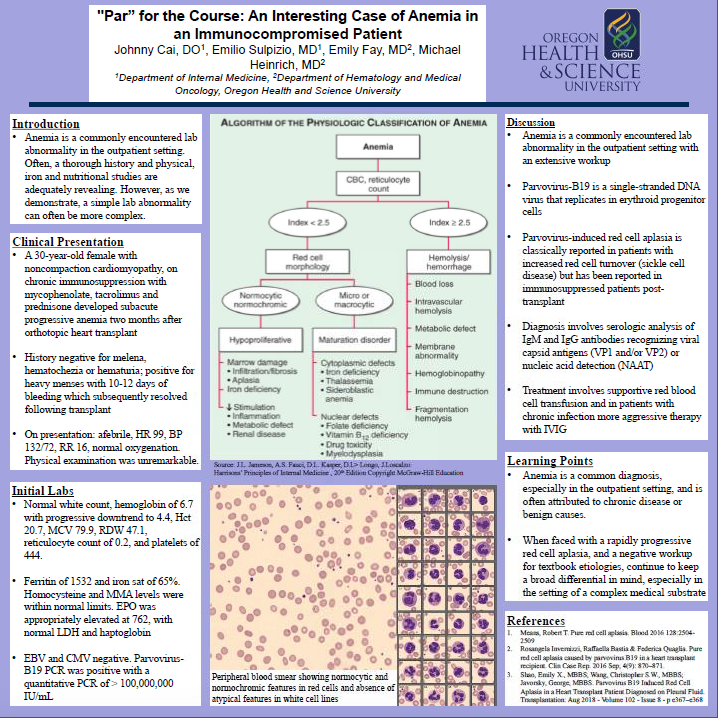
"Par" for the Course: An Interesting Case of Anemia in an Immunocompromised Patient
Johnny Cai, DO; Emilio Sulpizio, MD; Emily Fay, MD
Faculty Mentor: Michael Heinrich, MD
All clinicians will encounter anemia, and often we attribute this to chronic disease or benign causes. However, when faced with a rapidly progressive red cell aplasia, and a negative workup for textbook etiologies, we are forced to expand our differential, especially in the setting of a complex medical substrate. Parvovirus-B19 is a single-stranded DNA virus that replicates in erythroid progenitor cells. Though rare, in immunosuppressed individuals, inability to clear the virus may result in severe red cell aplasia. Parvovirus-induced red cell aplasia is classically reported in patients with increased red cell turnover (sickle cell disease) but has been reported in immunosuppressed patients post-transplant. Our case underscores the importance of developing a broad differential in the workup of common complaints, especially in immunosuppressed patients.
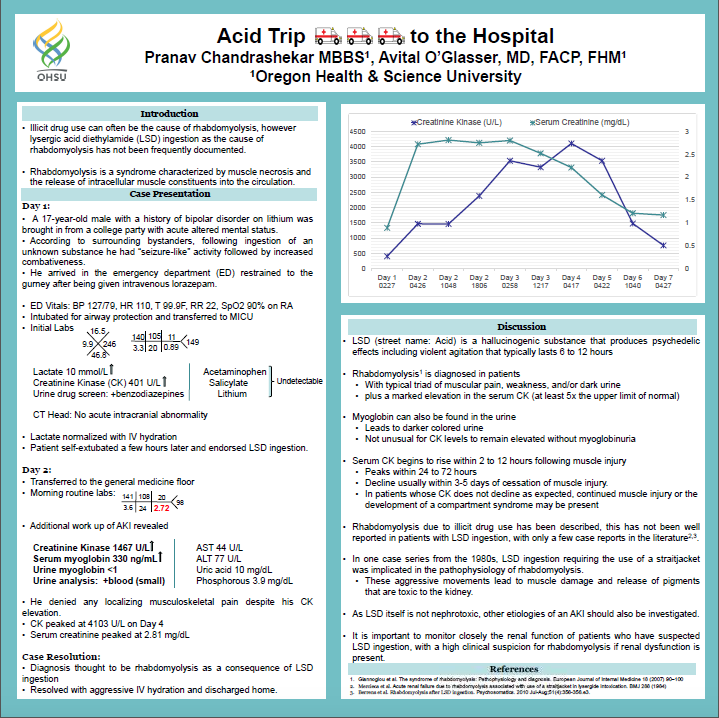
Pranav Chandrashekar, MBBS
Faculty Mentor: Avital O'Glasser, MD
Rhabdomyolysis is a syndrome characterized by muscle necrosis and the release of intracellular muscle constituents into the circulation. Although rhabdomyolysis due to illicit drug use has been described, this has not been well reported in patients with LSD ingestion, with only a few case reports appearing in the literature. As LSD itself is not nephrotoxic, other etiologies of an AKI should be investigated. LSD can lead to hallucinations and violent agitation, with patients often being restrained physically. In one case series from the 1980s, LSD ingestion requiring the use of a strait jacket was implicated in the pathophysiology of rhabdomyolysis. These aggressive movements lead to muscle damage and release of pigments that are toxic to the kidney. It is important to monitor closely the renal function of patients who have suspected LSD ingestion with a high clinical suspicion for rhabdomyolysis.
When Tissue Becomes the Issue: A Lesson on Atypical Complications of Waldenstrom Macroglobulinemia
Kimberly E. Chesteen, MD
Faculty Mentor: Alan J. Hunter, MD, FACP
Unlike multiple myeloma, there is no association between WM and plasmacytoma. However infiltrative extramedullary WM may present on imaging as an infiltrative mass with pathology resembling plasmacytoma. It is estimated extramedullary disease is only present in 4.4% of WM cases with the common locations involving the lungs, CSF, soft tissue, and bone. In regards to aVWS in WM, there are many proposed mechanisms including absorption of von Willebrand factor (vWF) into cells, autoantibodies against vWF, and shear force from increased viscosity. A retrospective study shows a clear association between increasing IgM levels and risk of acquired-vWD, however, but no apparent increased risk of infiltrative disease.
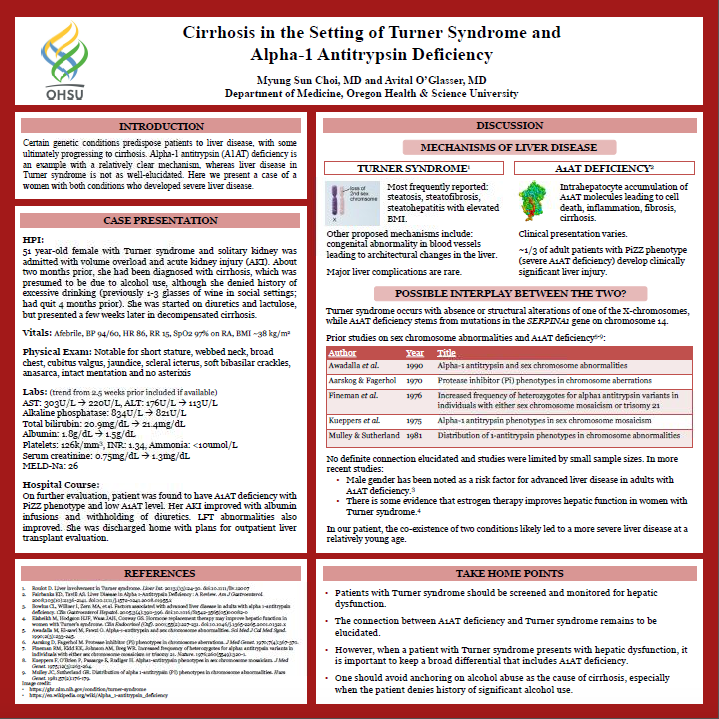
Cirrhosis in the Setting of Turner Syndrome and Alpha-1-Antitrypsin Deficiency
Myung Sun Choi, MD
Faculty Mentor: Avital O'Glasser, MD
A1AT deficiency leads to liver disease via intrahepatocyte accumulation of A1AT protein. Turner syndrome is associated with liver disease through unclear mechanism. Interestingly, male gender has been noted as a risk factor for predisposition to advanced liver disease in adults with A1AT deficiency, and there is some evidence that estrogen therapy improves hepatic function in women with Turner syndrome. This raises the question of some interplay between the A1AT genetic mutation of the SERPINA1 gene on chromosome 14 and sex hormones. When a patient with Turner syndrome presents with hepatic dysfunction, it would be important to keep a broad differential that includes A1AT deficiency rather than anchoring on the unclear association between Turner Syndrome and LFT abnormalities, as well as avoiding anchoring on alcoholic cirrhosis.
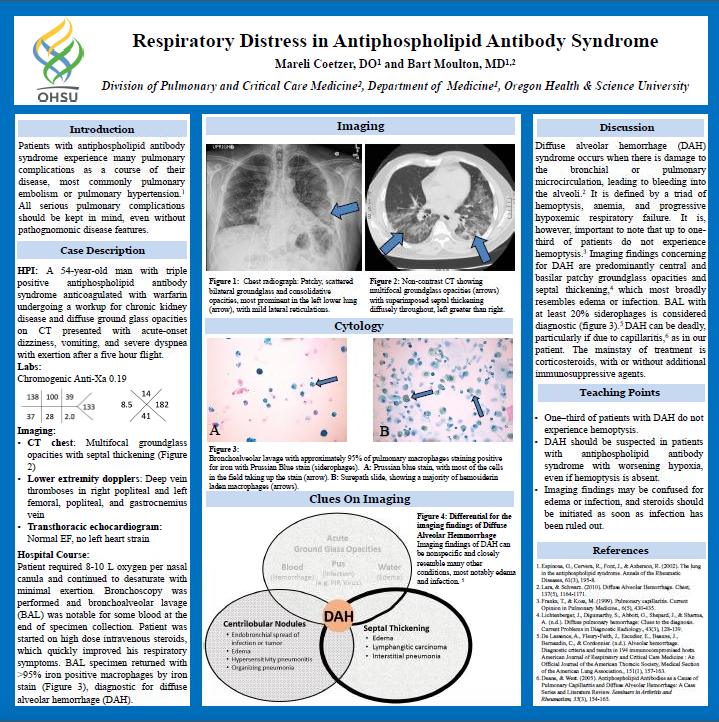
Acute Respiratory Distress in Antiphospholipid Antibody Syndrome
Mareli Coetzer, DO
Faculty Mentor: Bart Moulton, MD
DAH is a syndrome where damage to the bronchial or pulmonary microcirculation leads to bleeding into the alveoli. Patients most commonly experience hemoptysis, anemia, diffuse radiographic pulmonary infiltrates, and hypoxemic respiratory failure. End-organ damage in antiphospholipid antibody syndrome is commonly thought to be due to thromboses, however pulmonary capillaritis in antiphospholipid antibody syndrome may be induced by antiphospholipid antibody-mediated endothelial cell activation, as well as upregulation of cytokines and adhesion molecules. DAH should be suspected in patients with antiphospholipid antibody syndrome with worsening hypoxia, even if hemoptysisis absent and initial airway examinations do not show frank blood. In our patient given the rapid improvement we suspected capillaritis was the major cause of his decompensation.

"I Can't Swallow": A Story of An Unusual Hypopharyngeal Mass
Caroline M. Doan, DO, Namisha Thapa, DO
Faculty Mentor:Joseph Chiovaro, MD
Dysphagia, especially with vocal alteration, can be alarming due to concern for airway compromise. The differential of dysphagia is broad; thus, a thorough patient history is crucial and can provide invaluable clues toward the underlying diagnosis. Hypopharyngeal masses present a broad differential and require extensive workup and involvement of multiple specialists. This case illustrates a rare presentation of post-intubation trauma-related mass in a gentleman with cervical osteophyte that further complicated his course and management. On literature review, there are few reported cases of post-intubation granulation tissue formation of vocal cords, but to our knowledge, this is the first of this size with complication leading to osteomyelitis. Furthermore, this case highlights the importance of noting patient's past medical history.
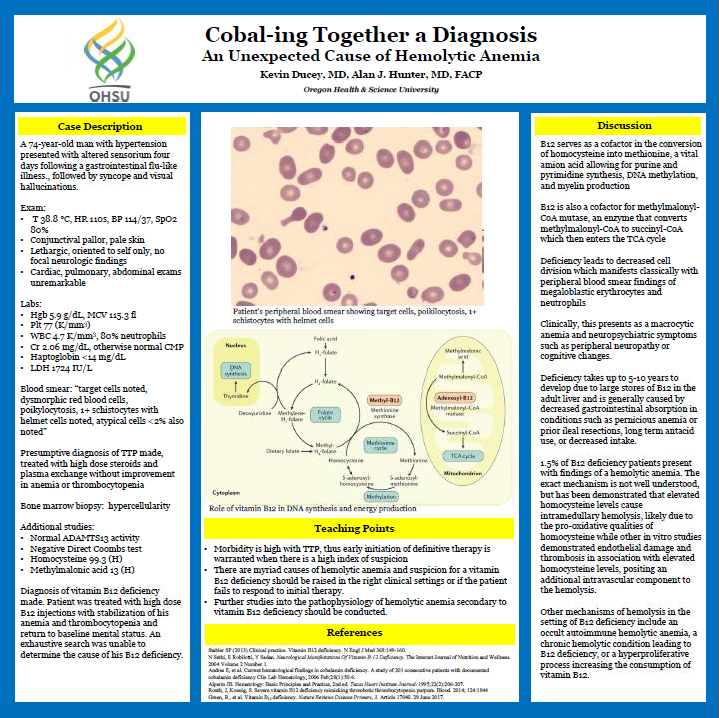
Cobal-ing Together a Diagnosis: An Unexpected Cause of Hemolytic Anemia
Kevin Ducey, MD
Faculty Mentor: Alan J. Hunter, MD, FACP
Approximately 1.5% of B12 deficiency patients present with hemolytic anemia. It has been demonstrated that elevated homocysteine levels cause intramedullary hemolysis, likely due to the pro-oxidative qualities of homocysteine. Additionally, in vitro studies demonstrated endothelial damage and thrombosis in association with elevated homocysteine levels, positing an additional intravascular component to the hemolysis. Other mechanisms of hemolysis in the setting of B12 deficiency include an occult autoimmune hemolytic anemia, a chronic hemolytic condition leading to B12 deficiency, or a hyperproliferative process increasing the consumption of vitamin B12. Suspicion for a vitamin B12 deficiency should be raised in the right clinical settings or if the patient fails to respond to initial therapy.
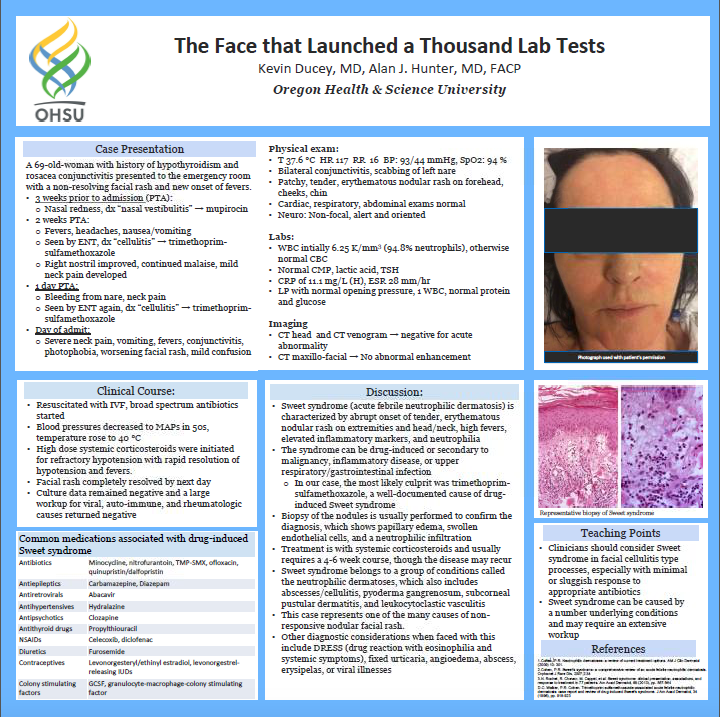
The Face that Launched a Thousand Lab Tests
Kevin Ducey, MD
Faculty Mentor: Alan Hunter, MD, FACP
Sweet syndrome (acute febrile neutrophilic dermatosis) is characterized by abrupt onset of tender, erythematous nodular rash on extremities and head/neck, high fevers, elevated inflammatory markers, and neutrophilia. The syndrome can be drug-induced or secondary to malignancy,inflammatory disease, or upper respiratory/GI infection. Treatment is with systemic corticosteroids and usually requires a 4-6 week course. Unfortunately, in this case, the diagnosis was never confirmed by biopsy due to the rapid resolution of the facial rash with steroid treatment. This case represents one of the many causes of non-responsive nodular facial rash. Clinicians should consider Sweet syndrome in facial cellulitis type processes, especially with minimal or sluggish response to appropriate antibiotics.
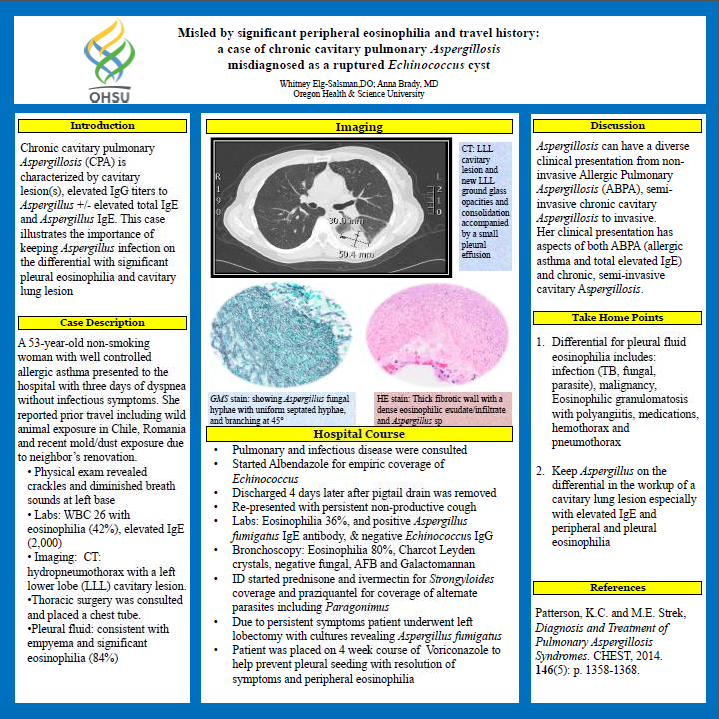
Whitney Elg-Salsman, DO
Faculty Mentor: Anna Brady, MD
Chronic cavitary pulmonary aspergillosis (CPA) is characterized by cavitary lesion(s), elevated IgG titers to aspergillus +/-elevated total IgE and aspergillus IgE. It is more common in patients with pre-existing pulmonary disease. Aspergillosis can have a diverse clinical presentation from non-invasive Allergic Pulmonary Aspergillosis (ABPA), semi-invasive chronic cavitary aspergillosis to invasive. This case illustrates the importance of keeping aspergillus infection on the differential with significant pleural eosinophilia and cavitary lung lesion even with a travel history that may be suggestive of parasite exposure. This case reveals the importance of always keeping aspergillosis on the differential in patients with underlying lung disease, cavitary nodules, elevated IgE and both peripheral and BAL eosinophilia.
Lessons from the Lonely Neutrophil
Miles Grovenburg, MD
Faculty Mentors: James Clements, MD; Joseph Shatzel, MD
Clinicians are well versed in the management of febrile neutropenia in the setting of myelosuppressive chemotherapy. However, this case highlights an unusual etiology of isolated neutropenia to illustrate a diagnostic approach to patients experiencing the sequelae of neutropenia as their initial presentation. A careful and detailed history cannot be understated as temporally associated medication exposures are often implicated given their potential to cause dose-dependent neutropenia as seen with chemotherapeutic agents to severe neutropenia (ANC 500) as with idiosyncratic drug reactions. However, a comprehensive evaluation also includes testing for micronutrient deficiencies and infectious exposures if history alone is unable to establish a diagnosis. Less commonly, a diagnosis of autoimmune or malignancy associated neutropenia can be established with serologies and/or flow cytometry.
Jessica Haraga, MD
Faculty Mentor: Sarah Diamond, MD
Epstein Barr Virus (EBV) is an uncommon cause of hepatitis and an even more uncommon cause of biliary dilation and obstruction. Other causes of obstruction should be investigated if clinical suspicion is high (degree of cholestasis) despite negative imaging. This case illustrates the nuances of liver function tests and the subtlety of pancreatic adenocarcinoma, especially on imaging studies. Although EBV does cause hepatocellular injury, it very rarely causes this degree of biliary obstruction and cholestasis, so other more common etiologies should be excluded.

Eliot Hill, MD
Faculty Mentor: Wayne Clark, MD
Thrombocytopenia is a common finding among in patients with a broad differential. Heparin-induced thrombocytopenia is one etiology that can present in a dramatic manner with potentially life-threatening complications requiring abrupt changes in management. Heparin-induced thrombocytopenia is a rare but potentially life-threatening cause of thrombocytopenia. It is important to remember that thrombosis, either arterial or venous, can be the presenting feature in 25% of patients with HIT. In a small subset of cases, this entity can present with cerebral venous thrombosis (CVT) manifesting as acute neurologic changes. Any patient with suspected HIT should have prompt discontinuation of all heparin products and be transitioned to a non-heparin anti-coagulant. Thus, the diagnosis of CVT should prompt investigation of risk factors for pro-thrombotic conditions based on specific patient characteristics.
Hospital-acquired AKI: When "Blame the Vancomycin" is not the Answer
Joel Horton, MD, Patrick Kelly
Faculty Mentor: Avital O'Glasser, MD, Sima Desai, MD
Methicillin Resistant Staphylococcusaureus (MRSA) bacteremia and acute kidney injury (AKI) are commonly encountered hospital medicine problems. This case highlights an uncommon and potentially devastating complication of staphylococcal infection. IgA-dominant glomerulonephritis presents with hematuria, heavy proteinuria, and AKI in the setting of ongoing infection. This glomerulonephritis is a variant of post-infectious GN. This is a highly morbid disease, in one cohort of 83 patients with staphylococcal-associated glomerulonephritis, 22.9% of patients progressed to ESRD and 14.5% died. This should be contrasted with the more commonly considered post-streptococcal glomerulonephritis where >90% of children and young adults experience a full recovery of renal function.
Steven T Koprowski, MD; Michael Loudin, MD
Gallstone ileus is rare in the general population; however, the proportion is much higher in older populations, approaching 25% of total mechanical bowel obstructions in patients aged 65 and older. Up to one third of the affected patients suffer from serious medical comorbidities. Literature on intervention strategies are limited to retrospective reports with optimal intervention remaining unclear. Recurrence of gallstone ileus reaches 5%, which provides a unique dilemma for treatment approaches in patients already at higher per-operative risk. After review of the literature, enterolithotomy alone appears to have the most optimal mortality profile versus bowel resection and one-step procedures. Observation for spontaneous passage of stone is an acceptable strategy.
Fibrinogen Positive Ground-Glass Hepatocytes in a Patient with Ulcerative Colitis
Steven T Koprowski, MD; Yumi Ando, MD; Christian Lanciault, MD, PhD
Faculty Mentor: Janice Jou, MD, MHS
A rarely reported finding, fibrinogen accumulation in hepatocytes can occur from inherited disease and from acquired errors in endoplasmic reticulum processing in a setting of metabolic stress. Ground glass hepatocyte inclusions staining positive with fibrinogen have only been associated only with the acquired causes in humans. Our patient had no known family history of liver disease, but definitely fit the picture of acute metabolic stress. In three cases with similar transaminase elevations and pathologic presentation, patients saw resolution of liver disease after removal of the acute stressor. Our patient seems to be following the same clinical course, but should continue to follow with a hepatologist for resolution.
Rachel K. Laursen, MD
Faculty Mentor: Alan J. Hunter, MD
Acute rheumatic fever (ARF) is an inflammatory disease involving cardiac and joint tissue that develops due to inadequately treated group A streptococcal (GAS) infection. In cases with cardiac involvement, secondary prophylaxis involves monthly injections of penicillin G for a duration of ten years. Recurrence of ARF is associated with history of carditis and lack of adherence to secondary prophylaxis. This case highlights the importance of recognizing and managing the once common syndrome of recurrent ARF as well as the roles of therapeutic adherence and access-to-care in achieving successful outcomes in the management of chronic illnesses. Further research is necessary for improved evidence-based decision-making in cases with high clinical suspicion for recurrent ARF.
Be Persistent to Kick Persistent Norovirus!
Melissa Rae LeBlanc, MD
Faculty Mentors: Alan Hunter, MD, Stephanie Halvorson, MD
Norovirus,an RNA enterovirus, causes a self-limited gastroenteritis in immunocompetent hosts. In immunocompromised hosts, infection can cause severe, persistent diarrhea lasting months, even years, causing significant morbidity, mortality and decreased quality of life. There are minimal therapeutic options aside from supportive care with limited, but growing, data regarding treatment. Therapeutic techniques for chronic norovirus are few with primarily case series or case reports reporting treatment options. Reduction in immunosuppression can allow increased immune function to improve viral clearance. Many case series use this technique in conjunction with novel treatments, though none report this technique in isolation.
Highs and Lows: A Tale of Supine Hypertension and Orthostatic Hypotension
Melissa LeBlanc, MD, Jessica Harraga MD
Faculty Mentor: Joseph Chiovaro, MD
Sometimes in medicine, we come across clinical conundrums. Such is the case in the medical management of supine hypertension and orthostatic hypotension, as treatment of one often worsens the other. These two clinical entities occur in higher frequencies in elderly populations, each difficult to treat alone and exponentially more difficult when occurring simultaneously.
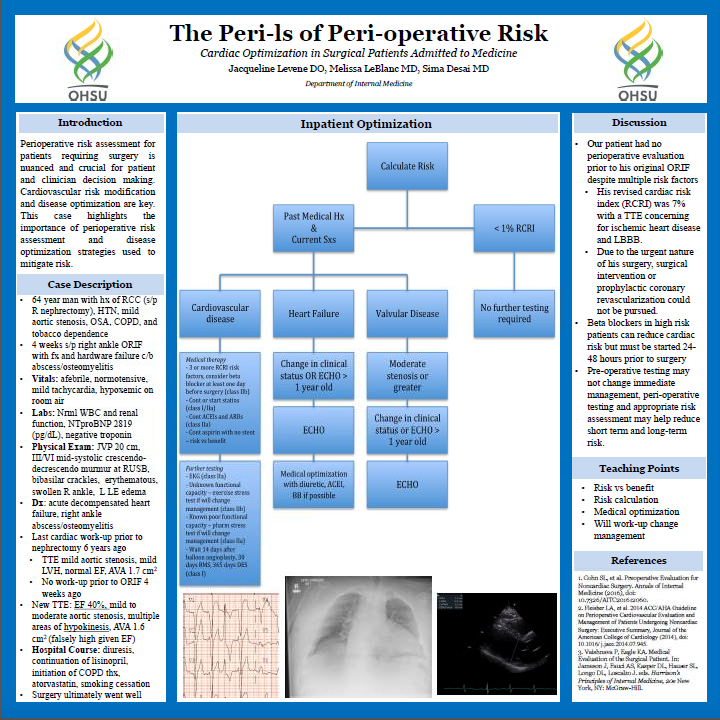
The Peri-ls of Peri-operative Risk
Jacqueline Levene DO, Melissa LeBlanc MD
Faculty Mentor: Sima Desai MD
Perioperative risk assessment for patients requiring surgery is nuanced and crucial for patient and clinician decision making. There are many pre and peri-operative risk calculators. In the setting of required surgical intervention, risk modification and disease optimization are key. Cardiac risk assessment requires the use of more than just automated calculators, but instead a well thought out exploration of individual risk factors and disease optimization. Just as surgical urgency may limit the extent to which risk is mitigated, so does knowledge of risk prior to surgery increase awareness post-operatively for cardiac and pulmonary events.
Ocular Syphilis, the Great Masquerader
Justin Lewis, MD
Faculty Mentor: Christina Flaxel, MD
Syphilis typically advances through four different stages (primary, secondary, latent, and tertiary), and ocular syphilis can develop during any of these stages. It is a rare condition that can involve any structure of the eye and mimic a variety of eye diseases. The most effective way to detect ocular syphilis early is a familiarity with its presentation, which is difficult because of its varied symptomatology. One case series reported that macular edema was present in 52% of ocular syphilis patients; another case series reported that uveitis was the most common symptom, and that case series featured six patients with retinal detachment. If we see mention of macular edema, uveitis, and/or retinal detachment on chart review in a patient with unspecified ocular symptoms and high-risk sexual behavior, then a syphilis work-up should be pursued.
Treating Cryptosporidium with Immunoglobulin, an Alternative Approach
Justin Lewis, MD
Faculty Mentor: David Jacoby, MD
Infection with the intracellular parasite Cryptosporidium causes self-limited diarrhea in immunocompetent hosts, but severe diarrhea resulting in weight loss and malabsorption in immunocompromised hosts. Although it is typically treated with antibiotics and antiparasitics, a novel approach with oral immunoglobulin can be utilized. Although there are limited case reports of using immunoglobulin for Cryptosporidiosis, the powder form of immunoglobulin has demonstrated treatment promise in HIV-positive patients. Oral immunoglobin should therefore be considered to treat Cryptosporidium in immunocompromised patients if the patient is not recovering with nitazoxanide +/- antibiotic therapy.
Ingrid Lindquist, MD, Ashley Dorneaton
Faculty Mentor: Shadi Mayasy, MD
The patient's acute onset of RUQ pain and liver enzyme derangement following the administration of ceftriaxone, and brisk improvement after its discontinuation, make acute toxic hepatitis secondary to ceftriaxone the most likely etiology of this transient cholestatic hepatitis. Although there are case reports on infectious perihepatitis, this condition is most commonly associated with pelvic inflammatory disease with vaginal discharge and pelvic tenderness, both of which were notably absent. Additionally, the fact that she had symptoms of pyelonephritis for several daysbefore presenting to the hospital, as well as normal LFTs and absent abdominalpain at presentation supports a ceftriaxone-induced acute cholestatic hepatitis etiology. Several case reports describe a ceftriaxone-induced cholestatic hepatitis.
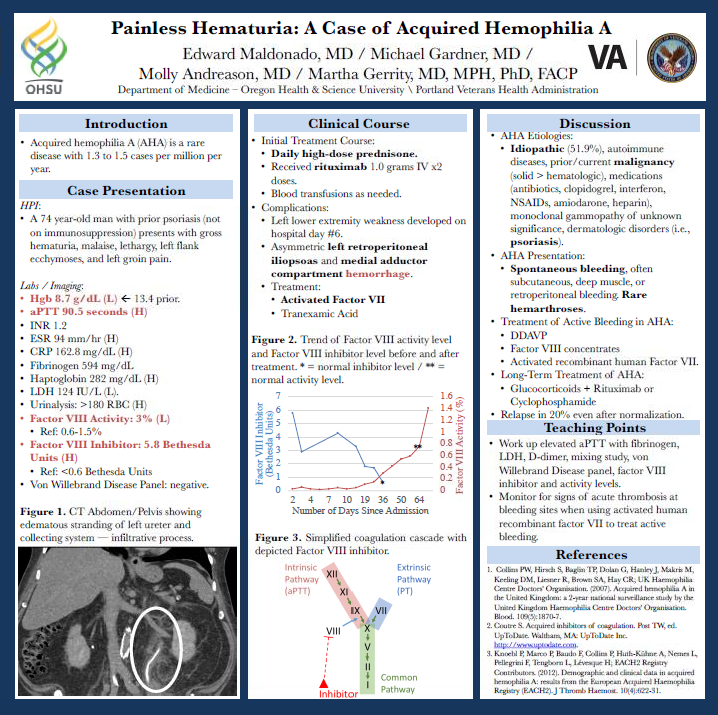
Painless Hematuria: A Case of Acquired Hemophilia A
Edward B. Maldonado, MD; Michael Gardner, MD; Molly Andreason, MD
Faculty Mentor: Martha Gerrity, MD
Among rarely encountered acquired inhibitors ofcoagulation, factor VIII inhibitors are the most common. AHA is idiopathic in 51.9% of cases with 89% being identified after an initial bleeding episode. Other etiologies of AHA include autoimmune diseases, malignancy, pregnancy, medications, monoclonal gammopathy of unknown significance, polymyalgiarheumatica, or dermatologic conditions. AHA usually presents with spontaneous bleeding, often subcutaneous/deep muscle or retroperitoneal bleeding. Rarely do patients present with hemarthroses, which are common in congenital hemophilia A. Testing should include coagulation studies, a mixing study for inhibitorscreen, and factor VIII activity and inhibitor levels.
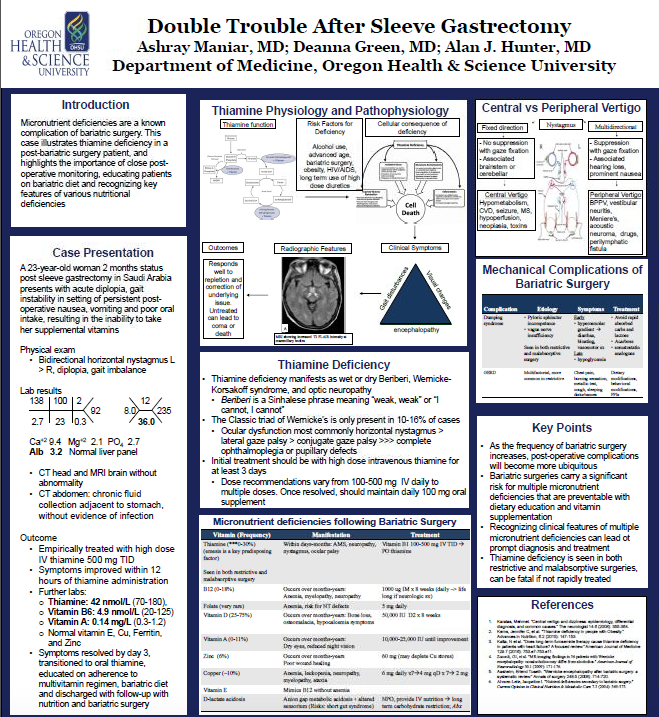
Double Trouble in a Bariatric Patient
Ashray Maniar MD, Deanna Green, MD
Faculty Mentor: Alan J. Hunter, MD, FACP
The increasing prevalence of obesity in the United States parallels the rise in performance of bariatric surgeries. Thus, it is important that clinicians recognize and manage both immediate and latent post-surgical complications. Common complications following both malabsorptive and restrictive bariatric surgery include reflux, dumping syndrome, and micronutrient deficiencies that can manifest early or late following surgery. Without frequent education, appropriate supplement regimens, and patient/physician vigilance these deficiencies can be severe. This case underscores the importance of recognizing and managing post bariatric surgery nutritional deficiencies and specifically the clinical syndrome of thiamine deficiency, previously described as bariatric beriberi.
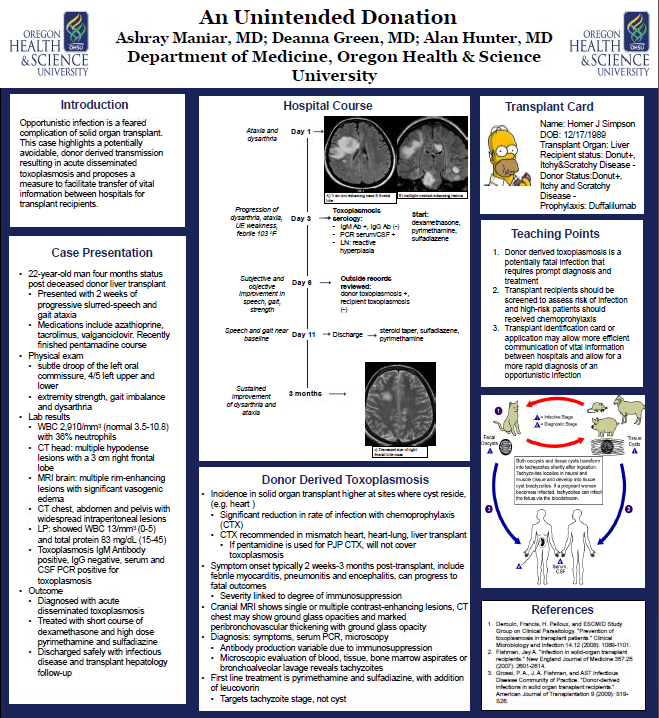
Ashray Maniar, MD; Deanna Green, MD
Faculty Mentor: Alan J. Hunter, MD, FACP
The incidence of toxoplasmosis in solid organ transplant patients decreased significantly with chemoprophylaxis, however infections still occur. Affected individuals typically present with varying neurologic/respiratory features that can be rapidly fatal with severity linked to degree of immunosuppression. Graft derived toxoplasmosis transmission typically occurs within the first three months, and reactivation or acute infection typically occurs after 3 months. Donor graft-associated transmission tends to be a more severe syndrome due to recipient seronegativity. Infection should be suspected on basis of risks, symptoms, and radiographic evidence of rim-enhancing intracranial llesions, with confirmation by antibody testing and PCR analysis. Although preventative measures have reduced donor transmitted toxoplasmosis, this case highlights the importance of identifying antecedent infectious status in donor organs for recipient patients.
POCUS on the Move in Internal Medicine! Diagnosis of Infected Thrombus in Transit
Kelsi Manley, MD; Joel Burnett, MD
Faculty Mentor: Kevin Piro, MD
Point of care ultrasound (POCUS) is a powerful tool that can augment the clinician physical examination and improve clinical care. Recently, the ACP formally acknowledged POCUS's important role in internal medicine. We highlight the value of POCUS by describing its role in diagnosing a right ventricular thrombus that may have otherwise escaped detection. In this case, a patient with CRBSI was preparing for discharge after standard management, when POCUS done by bedside providers diagnosed a thrombus that otherwise would have escaped detection, and radically changed the patient's management. As evidenced by this case, POCUS in the hands of internists can extend the physical exam to play a powerful role in"ruling in" endocarditis and targeting appropriate confirmatory studies.
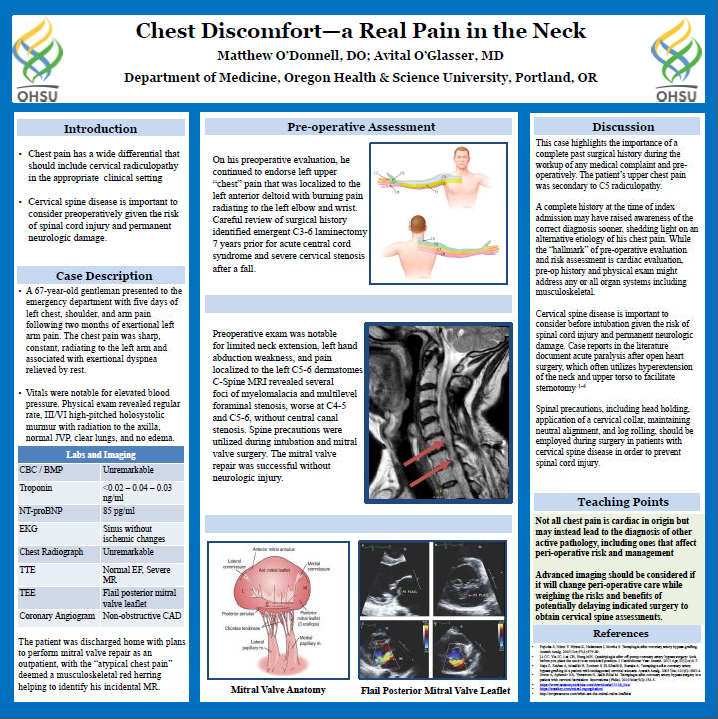
Chest Discomfort—a Real Pain in the Neck
Matthew O'Donnell, DO
Faculty Mentor: Avital O'Glasser, MD
This case highlights the importance of a complete past surgical history during the workup of any medical complaint and pre-operatively. The patient's upper chest pain was likely C5 radiculopathy. A complete history at the time of his index admission may have raised awareness of this sooner shedding light on an alternative etiology of his chest pain. Cervical spine disease is important to consider before intubation given the risk of spinal cord injury and permanent neurologic damage. Case reports in the literature document acute paralysis after open heart surgery, which often utilizes hyperextension of the neck and upper torso to facilitate sternotomy. Advanced imaging should be considered if it will change peri-operative care while weighing the risks and benefits of potentially delaying indicated surgery to obtain cervical spine assessments.
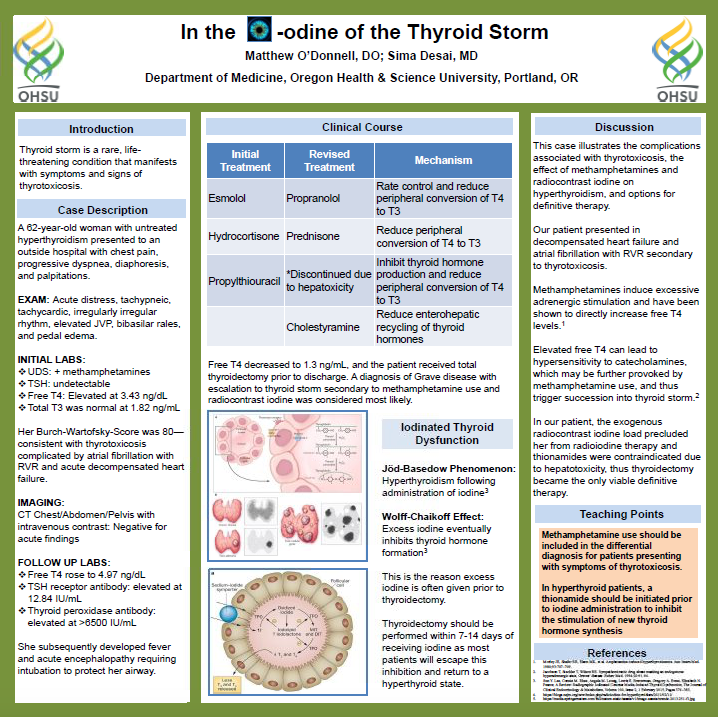
In the I-odine of the Thyroid Storm--3rd Place
Matthew O'Donnell, DO
Faculty Mentor: Sima Desai, MD
Thyroid storm is a rare, life-threatening condition that manifests with symptoms andsigns of thyrotoxicosis. This case illustrates the complications associated with thyrotoxicosis, the effect of methamphetamines and radiocontrast iodine on hyperthyroidism, and options for definitive therapy. Methamphetamines induce excessive adrenergic stimulation and have been shown to directly increase free T4 levels. Additionally, in hyperthyroid patients, a thionamide should be initiated prior to iodine administration to inhibit the stimulation of new thyroid hormone synthesis (the Jöd-Basedow phenomenon). Following an initial increase in hormone synthesis, a large exogenous iodine load inhibits thyroid hormone formation—the Wolff-Chaikoff effect, which is the reason it is often given prior to thyroidectomy.
Pump the Brakes: A Case of Toxic Alcohol Ingestion
Ishan Patel, MD; Riana Wurzburger, MD
Faculty Mentor: Ran Ran, MD
Ingestion of various commonly sold chemicals occur frequently every year. Prompt recognition and management are key to the survival and limiting morbidity, including seizures, multi-organ failure, and death. Prompt identification, consultation with Poison Control, initiation of temporizing measures, and transfer to higher level of care for definitive management ultimately lead to a positive outcome for this patient.
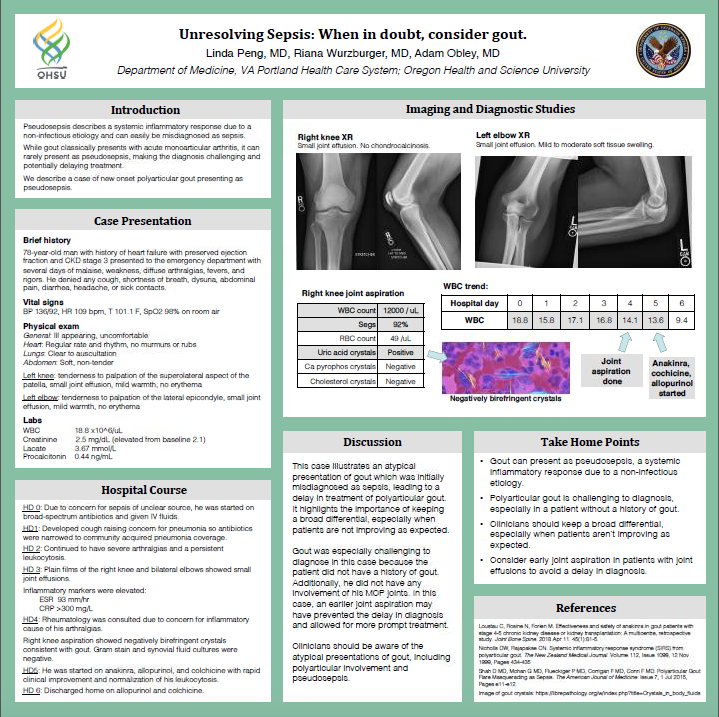
Unresolving Sepsis: When in Doubt Consider Gout
Linda Peng, MD, Riana Wurzburger, MD
Faculty Mentor: Adam Obley, MD
Pseudosepsis describes a systemic inflammatory response due to a non-infectious etiology and can easily be misdiagnosed as sepsis. While gout classically presents with acute monoarticular arthritis, it can rarely present as pseudosepsis, making the diagnosis challenging and potentially delaying treatment. We describe a case of new onset polyarticular gout presenting as pseudosepsis. This case illustrates an atypical presentation of gout which was initially misdiagnosed as sepsis, leading to a delay in treatment of polyarticular gout. It highlights the importance of keeping a broad differential, especially when patients are not improving as expected. Clinicians should be aware of the atypical presentations of gout, including polyarticular involvement and pseudosepsis.
Jenna Petersen, MD
Faculty Mentor: Timothy Flynn, DO
The differential for limbic encephalitis includes: 1) paraneoplastic processes and 2) non-paraneoplastic processes, such as autoimmune encephalitis or viral infections (herpes simplex virus). Providers should consider autoimmune encephalitis early in the course in a patient with CSF lymphocytic pleocytosis and negative HSV PCR. In regards to the above case, it is possible that an earlier work-up for autoimmune etiology could have prevented the delay in diagnosis and allowed for consideration of treatment prior to the patient's deterioration. Patients with SLE have higher EBV viral loads and impaired EBV-specific T-cell responses, resulting in more frequent EBV reactivation. Limbic encephalitis in a patient with a positive EBV CSF PCR should prompt evaluation for CNS lupus.
Jenna Petersen, MD; Sven Olson MD
Faculty Mentor: Christopher Terndrup, MD
Post-transfusion purpura (PTP) should be considered in the differential for any patient with acute thrombocytopenia after a blood transfusion. The pathophysiology of PTP involves destruction of both transfused platelets and an individual's own antigen-negative platelets due to prior production of anti-platelet antibodies. Diagnosis is confirmed with serological testing showing the presence of anti-platelet alloantibodies and absence of the corresponding antigen on the individual's platelets. Though a diagnosis of PTP was given in this case, patient's negative serology and platelet drop within hours raises the question for an even rarer, but related syndrome of acutethrombocytopenia due to passive transfer of anti-platelet antibodies.
Remembering the Forgotten Disease
Francis Phan, MD; Melissa LeBlanc, MD
Faculty Mentor: Alan J. Hunter, MD, FACP
Lemierre syndrome, jugular vein suppurative thrombophlebitis, once known as "the forgotten disease", is characterized by infectious involvement of carotid sheath vessels with subsequent bacteremia and severe systemic complications. Fusobacterium species are the classic organism associated with Lemierre syndrome, particularly Fusobacterium necrophorum. This rare condition may subject a young otherwise healthy person presenting with pharyngitis to life threatening complications. This case illustrates the potential for a common complaint, to manifest into a rare and critical illness. This once common disease had diminished in incidence in the setting of widespread antibiotic use for pharyngitis. However, more recently, rates have increased as antibiotics are less often prescribed for pharyngitis due to concern for antibiotic resistance.
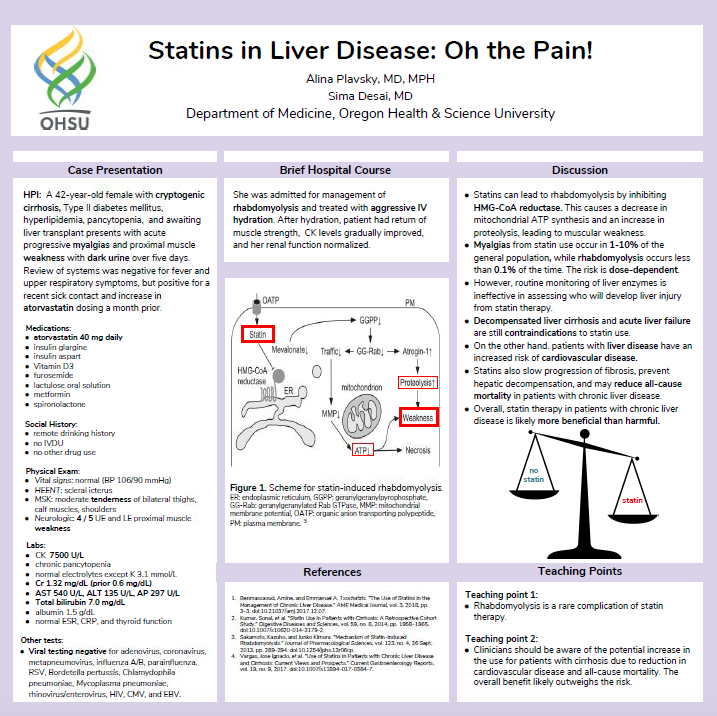
Statins in Liver Disease: Oh the Pain
Alina Plavsky, MD, MPH
Faculty Mentor: Sima Desai, MD
The patient's presentation was most consistent with rhabdomyolysis due to statin use. In the general population, side effects of myalgias from statin use occur in 1-10%, while rhabdomyolysis occurs less than 0.1% of the time. The risk is also dose-dependent. Since statins undergo first pass hepatic metabolism via cytochrome P450, patients with underlying liver disease are more susceptible to developing statin-induced myopathy and rhabdomyolysis due to decreased ability to clear statins. We demonstrate a case in which a patient with cirrhosis developed rhabdomyolysis after a dose increase of the medication. Clinicians prescribing statins should be aware of the potential increase in their use for patients with cirrhosis and balance this with the greater potential for complications.
Hidden Hawaiian Toxins: A Case of Ciguatera Poisoning
Tara Reed, MD
Faculty Mentor: Sydney Tatsuno, MD
Cases of nonbacterial food poisoning associated with fish is becoming increasingly common across the world with the increased transportation of imported fish. Most cases in the United States occur in Florida and Hawaii, usually involving tropical and semitropical coral reef fish. Ciguatera-toxin producing microalgae, Gambierdiscus toxicus, grow on dead coral and seaweed which are eaten by small fish. G. toxicus produces an odorless and tasteless neurotoxin that interferes with voltage-gated sodium channels leading to gastrointestinal and neurological symptoms. The toxins accumulate in largerfish who eat smaller fish who have been exposed to the toxin. Ciguatera poisoning is the most common seafood-toxin condition in the world, so clinicians need to be aware of this increasingly common poisoning.
Time is Tissue: A Delayed Diagnosis of Necrotizing Soft Tissue Infection
Emilio Sulpizio, MD; Johnny Cai, DO
Faculty Mentor: Akram Khan, MD
Facial edema is often benign. We present a less common presentation of necrotizing soft tissue infection (NSTI) that presented with facial edema and rapidly progressed to be life-threatening. The population-adjusted incidence of NSTIs has increased by 91% between 1999 and 2007. These infections are often not on the radar of physicians and with a high mortality (29-45%), a delay in diagnosis can have devastating consequences. As noted in our case, in up to 25% of patients, these classically taught findings are absent, and patients present atypically without fever, pain or erythema. This, coupled with recent evidence suggesting low sensitivity of previously validated clinical risk calculators, highlight the importance of maintaining a high degree of suspicion. Our case demonstrates that often life threatening diagnosis can masquerade as benign-appearing clinical presentations.
Not All Granulomas Come from Fish Tanks: A Chronic Non-Healing Hand Wound After Swimming
Namisha Thapa, DO
Faculty Mentor: Luke Strnad, MD
"Aquarium granuloma", "swimming pool granuloma", or "fish-tank granuloma" is a relatively uncommon infection in humans caused by the non-tuberculous mycobacterium, Mycobacterium marinum (M. marinum). It usually presents as a chronic, indolent, non-healing wound that requires meticulous history gathering, high clinical suspicion, and often skin biopsy to make the diagnosis. As a result, there is usually a time delay between symptom onset and diagnosis. This is a relatively underreported infection that goes undiagnosed for many years with an incidence of 0.04 to 0.27 per 100,000 patients. This case illustrates the indolent nature of this infection and delay in diagnosis, especially as it can be hard to culture depending on incubation temperature in lab. Early diagnosis is important as it can involve deeper structures with reported severe cases if spread does occur.
Beyond the Pancreas: A Lesson in Lipase Elevation
Ryan Threadgill, MD
Faculty Mentor: Adam Obley, MD
While significant lipase elevations are highly specific for pancreatitis (99% or greater at 3x the upper limit of normal), there are other causes of elevation related to its production, storage, and clearance. Lipase is primarily made and stored in pancreatic acinar cells, but it is also produced by the liver (hepatocytes and endothelial cells) and gastrointestinal tract (gastric chief cells in the gastric antrum, gastric angular notch, and epithelial cells of the duodenal bulb, esophagus, and gastroesophageal junction). The concentration of lipase is about 100 times greater in the pancreas than the liver or the bowel. Lipase is filtered by the glomerulus, reabsorbed by the renal tubules, and degraded in the kidney. Thus, non-pancreatic elevations of lipase are usually due to increased lipase release from other cells and decreased lipase clearance.
HIV Infection: a Covert Risk Factor for Coronary Artery Disease - 2nd Place
Tyler Wells, MD
Faculty Mentor: Melissa D. Murphy, MD
This case highlights the importance of recognizing HIV infection as an independent risk factor for the development of CAD. In this case, the patient's traditional cardiovascular risk factors include hyperlipidemia, male sex, and hypertension. However, the degree of obstructive CAD, including a totally occluded left anterior descending artery, is surprising given his relatively young age, benign family history, non-smoking status, and absence of diabetes. Proposed mechanisms for the etiology of increased cardiovascular events include an immune-mediated or inflammatory process leading to accelerated atherosclerosis. In addition to uninterrupted antiretroviral therapy, clinicians should aggressively manage cardiovascularrisk factors in patients with HIV and have a high suspicion of CAD in a patient presenting with atypical chest pain.
"To be or not to be a Type II NSTEMI"
Rachel Westwood, MD; Michael Gardner, MD
Faculty Mentor: Jeffrey Bien, MD
Type II Non-ST elevation myocardial infarction (NSTEMI) is a common diagnosis in hospitalized patients which is attributed to myocardial ischemia secondary to oxygen supply-demand mismatch. This physiology is distinct from ACS-NSTEMI (type I) which is due to plaque rupture; this distinction critically guides management. Treatment for Type II NSTEMI is directed at the underlying condition, whereas treatment for ACS-NSTEMI employs anti-platelet and anti-thrombotic medication as well as percutaneous coronary intervention. This case exemplifies the challenge of differentiating between type II NSTEMI and subacute type 1 NSTEMI. Moreover, this case highlights the conundrum of risks versus benefits in the treatment of a subacute MI when there are competing comorbidities, i.e. acute renal failure potentially requiring hemodialysis.
Susac Syndrome: A Clinical Triad… Eventually
Riana Wurzburger, MD
Faculty Mentor: Lindsey Wooliscroft, MD
Susac syndrome is a rare autoimmune microangiopathy that leads to microvascular occlusions in the brain, retina, and inner ear. It classically manifests with a clinical triad of encephalopathy, visual disturbances, and hearing loss. There are no specific biologic markers of Susac Syndrome, so the diagnosis is based largely on the clinical and radiographic findings. Diagnosing Susac Syndrome can be a challenge because of its rarity and its tendency to present with varied symptoms, often with significant time lapse before the clinical triad is fulfilled. This often leads to late diagnosis and delayed initiation of therapy. It is important to be aware of Susac Syndrome in the differential diagnosis for acute onset confusion.
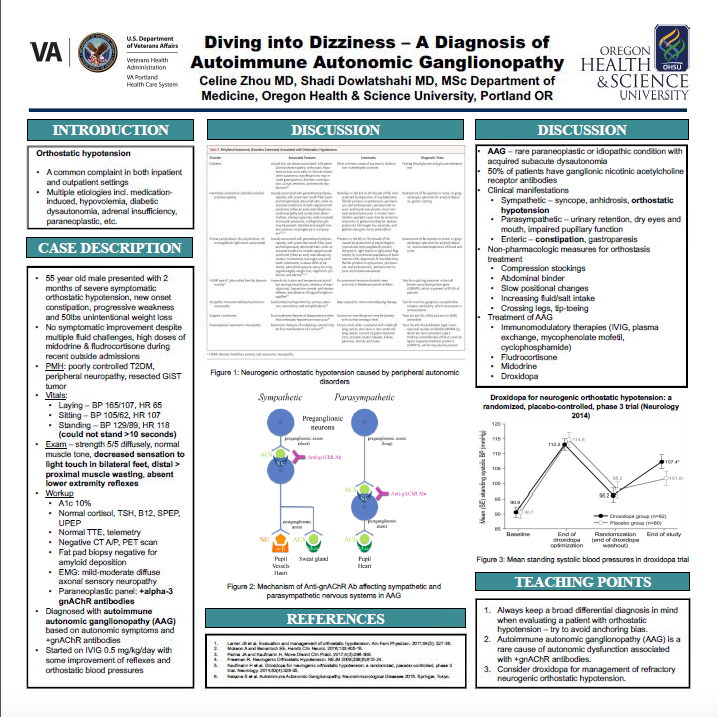
Diving into Dizziness - A Diagnosis of Autoimmune Autonomic Ganglionopathy
Celine Zhou, MD
Faculty Mentor: Shadi Dowlatshahi, MD, MSc
Orthostatic hypotension is a common complaint seen in both the inpatient and outpatient settings, and may be attributed to a multitude of etiologies including medications, hypovolemia, diabetic dysautonomia, adrenal insufficiency and paraneoplastic syndromes. AAG is a rare condition resulting in an acquired subacute dysautonomia related to ganglionic nicotinic acetylcholine receptor autoantibodies. Presence of these antibodies in combination with autonomic symptoms are key to diagnosis. Clinical manifestations of AAG are variable and include enteric (constipation, gastroparesis), sympathetic (syncope, anhidrosis, orthostatic hypotension) and parasympathetic (urinary retention, dry eyes/mouth, impaired pupillary function) dysfunction, with the most common symptom being orthostatic hypotension.
Clinical Research Posters
Joaquin Chapa, MD; Alyson Haslam, PhD
Faculty Mentor: Vinay Prasad, MD, MPH
Population cancer statistics are often used to assess the benefit of screening programs; however, discrepancies arise. Specifically, the results of randomized trials of screening often show disease specific morality reduction of approximately 15 to 20%, while population data show larger improvements (40-50%). We believe that the methods of measurement may explain this discordance.
Quality Improvement Posters
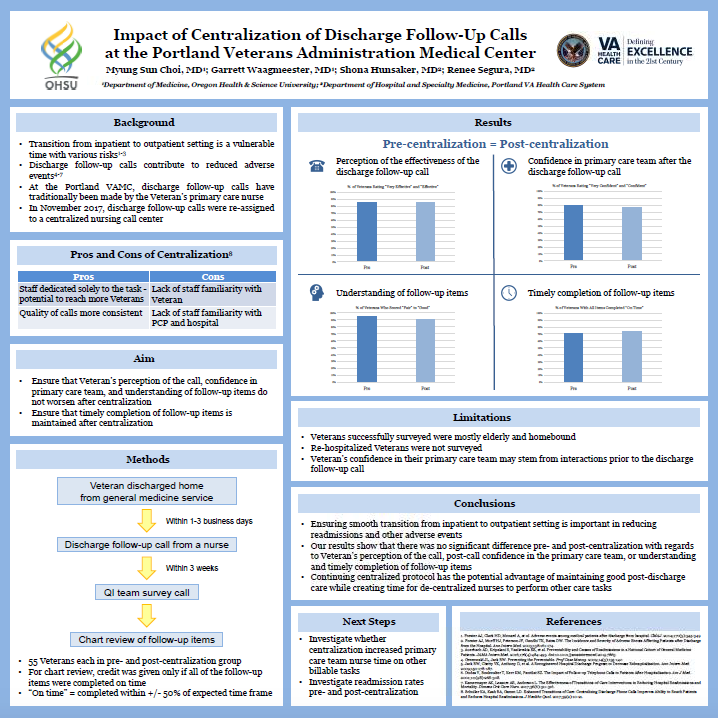
Myung Sun Choi, MD; Garrett Waagmeester, MD
Faculty Mentors: Shona Hunsaker, MD; Renee Segura, MD
Centralization of post-hospitalization discharge calls has potential advantage of the staff being dedicated solely to that task. Potential disadvantages include the fact that the nurse is not as familiar with the patient and the primary care team as the patient's nurse care manager. The PVAMC recently underwent centralization of follow-up calls for patients discharged from general medicine teams. Preliminary results from this study seems to indicate that this change did not have a significant impact in the rate of timely completion of follow-up items, patient's perception of the call, or his/her understanding of follow-up items. Based on this, it seems reasonable to continue with the centralized protocol with the potential advantage of opening up the nurse care managers' time for other tasks.
Anna Stecher, MD; Briana Ketterer, MD; Paige Sutherland, MD; Bernadette Zakher, MD; Alina Plavsky, MD, MPH; Kaleb Keyserling, MD; Garrett Waagmeester, MD; Brady Wright, MD
Faculty Mentor: Jacob Luty, MD
At OHSU, patients and families arrive at critical junctures of care under prepared for complex decisions. This can result in goal-discordant, aggressive end of life care, affecting resource utilization and patient-centered care and patient autonomy. A key aim was to improve advance care planning (ACP) at OHSU, which involves discussions to understand patients' goals of care. Documenting a surrogate decision maker (SDM) is a keystep in the continuum of ACP. The Electronic Medical Record (EMR) lacked a standard accessible location to document SDM information, and a culture of routine acquisition of such information was absent. Thus, we sought to improve ACP by process improvement and culture change around SDM acquisition for patients at OHSU.
High Value Cost Conscious Care Posters
Call Me Maybe? Improving Utilization of Telemedicine in a VA Resident Clinic - 1st Place
Kaleb Keyserling, MD; Jared Huber, MD
Faculty Mentor: Carol Sprague, MD
With rapid improvements in technology, telemedicine is becoming common place in modern medical practice, allowing patients quicker and more convenient access to health care and closer follow-up with providers. Many patients live in rural areas or have physical limitations making face to face visits difficult. Telemedicine is the use of technology to improve health care delivery and provide patients alternative ways to access care.